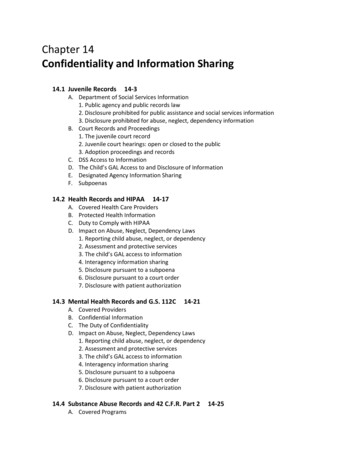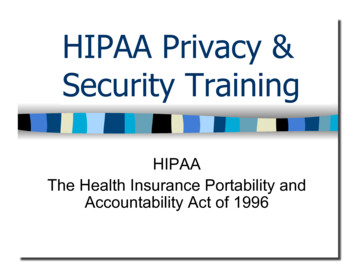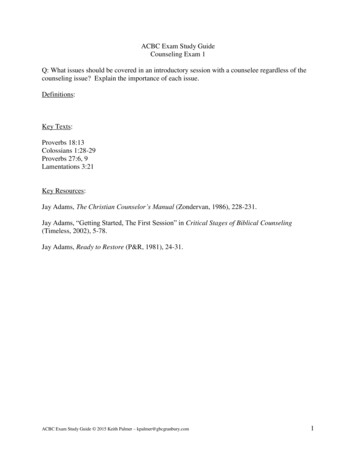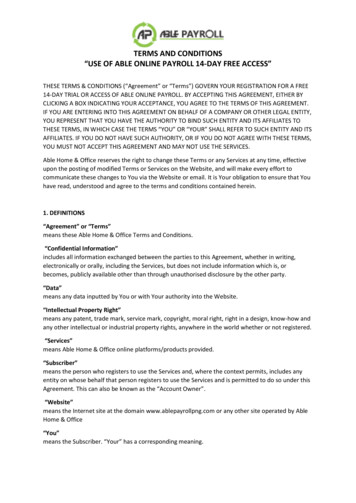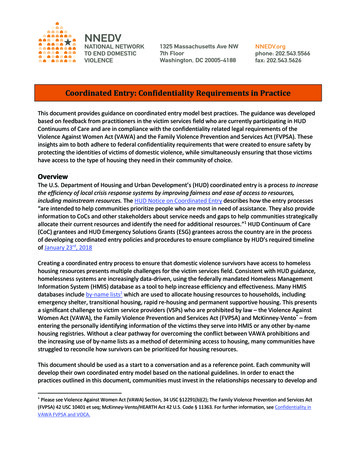
Transcription
Coordinated Entry: Confidentiality Requirements in PracticeThis document provides guidance on coordinated entry model best practices. The guidance was developedbased on feedback from practitioners in the victim services field who are currently participating in HUDContinuums of Care and are in compliance with the confidentiality related legal requirements of theViolence Against Women Act (VAWA) and the Family Violence Prevention and Services Act (FVPSA). Theseinsights aim to both adhere to federal confidentiality requirements that were created to ensure safety byprotecting the identities of victims of domestic violence, while simultaneously ensuring that those victimshave access to the type of housing they need in their community of choice.OverviewThe U.S. Department of Housing and Urban Development’s (HUD) coordinated entry is a process to increasethe efficiency of local crisis response systems by improving fairness and ease of access to resources,including mainstream resources. The HUD Notice on Coordinated Entry describes how the entry processes“are intended to help communities prioritize people who are most in need of assistance. They also provideinformation to CoCs and other stakeholders about service needs and gaps to help communities strategicallyallocate their current resources and identify the need for additional resources.”1 HUD Continuum of Care(CoC) grantees and HUD Emergency Solutions Grants (ESG) grantees across the country are in the processof developing coordinated entry policies and procedures to ensure compliance by HUD’s required timelineof January 23rd, 2018Creating a coordinated entry process to ensure that domestic violence survivors have access to homelesshousing resources presents multiple challenges for the victim services field. Consistent with HUD guidance,homelessness systems are increasingly data-driven, using the federally mandated Homeless ManagementInformation System (HMIS) database as a tool to help increase efficiency and effectiveness. Many HMISdatabases include by-name lists2 which are used to allocate housing resources to households, includingemergency shelter, transitional housing, rapid re-housing and permanent supportive housing. This presentsa significant challenge to victim service providers (VSPs) who are prohibited by law – the Violence AgainstWomen Act (VAWA), the Family Violence Prevention and Services Act (FVPSA) and McKinney-Vento* – fromentering the personally identifying information of the victims they serve into HMIS or any other by-namehousing registries. Without a clear pathway for overcoming the conflict between VAWA prohibitions andthe increasing use of by-name lists as a method of determining access to housing, many communities havestruggled to reconcile how survivors can be prioritized for housing resources.This document should be used as a start to a conversation and as a reference point. Each community willdevelop their own coordinated entry model based on the national guidelines. In order to enact thepractices outlined in this document, communities must invest in the relationships necessary to develop andPlease see Violence Against Women Act (VAWA) Section, 34 USC §12291(b)(2); The Family Violence Prevention and Services Act(FVPSA) 42 USC 10401 et seq; McKinney-Vento/HEARTH Act 42 U.S. Code § 11363. For further information, see Confidentiality inVAWA FVPSA and VOCA.*
implement a safe and confidential practice for survivors. The full collaboration and participation of VSPs inthe development and implementation of coordinated entry is critical to meet the federal confidentialityand survivor-centered safety requirements.Key Elements for Effective, Confidential Coordinated EntryA number of communities and states across the country have built effective coordinated entry processesthat are in compliance with VAWA and FVPSA, prioritizing the safety and confidentiality of the survivors.While NNEDV does not endorse a specific model or models, this document highlights innovativecoordinated entry practices that adhere to confidentiality requirements. HUD is encouraging CoCs to workwith the victim service providers in their community to establish either a process for their participation inthe CoC’s coordinated entry process or to establish their own coordinated entry process outside of theHMIS. NNEDV encourages communities to create an aligned or parallel coordinated entry process that isboth effective and responsive to the vulnerable populations and unique needs of individual communities.The examples highlighted below describe foundational elements of coordinated entry that are inclusive ofconfidentiality best practices and in compliance with VAWA and FVPSA.The coordinated entry homelessness and VSP partners provided critical feedback for the purposes ofcreating this best practices document and shared with us key elements to their on-going success. These areoutlined in the following subsections.Partnership and collaboration across systemsIn order to create a homelessness system that is responsive and equitable in prioritizing the mostvulnerable households across populations, the following strategies have been employed by communitiesdemonstrating a strong coordinated entry process: Ongoing relationship building across agencies and systems, as demonstrated through:o A foundational commitment to continued communication and collaboration betweenCoCs, homeless service providers and VSPs;o Mutually agreed upon shared principles, goals, and values that ensure equitable crosssystem access for survivors;o Agreed upon assessments specifically for survivors, and attention to trauma-informedapproaches to assessment that includes safety planningo Coordinated housing protocols designed to prioritize ongoing investment in relationshipbuilding;o Shared leadership on Continuum of Care (CoC) boards with meaningful involvementacross the VSP and homelessness systems;o State agencies, homeless coalitions, domestic violence and sexual assault coalitions, andlocal VSPs working together to develop coordinated entry processes;o Regular meetings between leadership of VSPs and homelessness and housing serviceproviders; ando VSPs active investment and participation in CoC or BoS statewide coordinated entry. Prioritizing ongoing, cross-systems training for housing and victim service providers, including:o Training for victim advocates on administering coordinated entry screening tools; ando Training for housing advocates on the unique needs of domestic violence, sexual assaultand stalking survivors and the complexities they face when rebuilding their lives.Coordinated Entry-Confidentiality Requirements in Practice (3/2018)2 of 6
A commitment to prioritizing ongoing technical assistance for homeless and victim serviceproviders.Model coordinated entry practices regarding shared referralsHow do we provide safety and protect a domestic violence survivor’s identity while also ensuring that thesurvivor has access to the type of housing they need, and in their community of choice? Here are a fewcoordinated entry protocols and models for consideration:Coordinated Entry Protocol Scenario:1. Assessment: A domestic violence survivor completes a trauma-informed and survivor-centeredassessment, as determined by the community, with a domestic violence advocate.2. Scoring and data collection: The result (often also known as a “score”) is collected and thecompleted screening tool is destroyed to protect the domestic violence survivor’s confidentiality. (Itis considered best practice to keep as little information as necessary in a domestic violencesurvivor’s client file while they are accessing VSP services.)3. Referral: According to VAWA and FVPSA, no personally identifying information can be sharedoutside of the referring VSP into a shared database such as an HMIS or an excel file or googledocument. As outlined below, only minimal information (and no personally identifiableinformation) should be provided to enable the survivor to be added to a by-name list. Drawingfrom the information received in the scoring and data collection stage, the domestic violenceadvocate completes a de-identified referral form without any personally identifying informationincluded. The non-personally identifying data entry fields (see listed below) can be sent to thecoordinated entry point of contact and entered into the by-name list. The following recommendeddata entry fields provide samples that are in compliance with VAWA and FVPSA requirements:Data Entry FieldReferral Date (notprogram entrydate)Location wheresurvivor seeksplacementCoordinated EntryAssessment ToolResultHousehold TypeDescription of FieldDate the domestic violence survivor’s unidentified information was sent tocoordinated entry. A referral date could be identifiable information if an abuserhas access to this information. It is necessary to change to referral date or leave itblank if the domestic violence survivor communicates safety and housing concernsrelated to documenting it. A program entry date could potentially be personallyidentifiable if coupled with other demographic information.Enter the geographic area(s) in which the domestic violence survivor is seekinghousing.The result the domestic violence survivor received from the coordinated entryscreening conducted by the VSP.The number of bedrooms the domestic violence survivor will need given theirfamily size. This data field is very important, as number of bedrooms is not apersonally identifying piece of information about a domestic violence survivor. Donot capture number of children in this category, because it is personallyidentifying information and would not be in compliance with VAWA/FVPSA.Coordinated Entry-Confidentiality Requirements in Practice (3/2018)3 of 6
ChronicallyHomelessDV-specificvulnerabilityPoint of Contact DV advocate at VSPagencyUnique Client ID#Is the domestic violence survivor chronically homeless by HUD’s definition?Yes/NoIs the domestic violence survivor identified as having higher needs or highervulnerabilities specifically associated with fleeing a domestic violence situation(i.e. serious danger, and other vulnerabilities related to the abuse such as housinginsecurity, and polyvictimization)? Many communities have chosen to prioritizedomestic violence survivors who are in high risk situations and in serious danger.Others have developed unique tools to specifically assess DV survivors’ housingneeds.The point of contact is the person who processes the domestic violence survivor’sapplication. They should provide their email and phone number so that thedesignated homeless system lead can contact them when a unit becomesavailable.This number is assigned by the point of contact and given to the designatedhomeless system lead. This number is a unique client identification number thatthe stand alone VSP creates and is not in any way identifying and cannot bedecoded by the designated homeless system lead.A note on assessments: some communities have developed a DV-specific assessment tool and somecommunities use their main assessment tool and use a separate tool to determine DV eligibility. Thereare pros and cons to both methods. More guidance is forth-coming on assessing vulnerability of DVsurvivors.Alternative to using by-name referral lists: To help facilitate the coordinated entry process, a live/sharedlist (which does not include personally identifying information) can be kept between two points of contactto ensure referrals are not missed. Below is an example of a shared live Excel document from a partnershipbetween the Connecticut Coalition Against Domestic Violence and the Connecticut Coalition to EndHomelessness (not entered into HMIS):Client Unique ReferralID#Submission cceptance DateCoordinated EntryNetwork Location12/21/16 Lakeview1/5/17 LakewoodNotesScore: 7Household type:2High RiskScore: 10Household Type:2 or3 High RiskCase conferencing: When housing becomes available, community agencies come together in a group caseconferencing process to negotiate and advocate for their program’s participants to receive housingplacement and resources. During this process, a domestic violence survivor working with a VSP may chooseto have the VSP share time-limited information with the group through the use of a time-limited consent torelease their information. Time-limited is typically defined as the amount of time needed to achieve a DVsurvivor’s goal in having the information released. This information would include information that the DVsurvivor consents to share related to their assessment, housing needs, including geographic location andpreference (PHS, RRH, TH) and vulnerability tool results. However, if a domestic violence survivor choosesnot to share their information due to safety or confidentiality reasons, it should not negatively impact theirCoordinated Entry-Confidentiality Requirements in Practice (3/2018)4 of 6
access to housing resources during the group decision-making process and their assessment tool(s) resultscan assist in prioritizing their need.Coordinated Entry Mainstream Access for Survivors:A domestic violence survivor who is receiving services from a VSP can also access the mainstreamhomelessness system’s housing resources by being referred directly to the CoC’s determined point of entry.If a DV survivor is referred directly and would like to receive mainstream homeless services through theCoC, VSPs should consider the following areas and work with the CoC and CE process to ensure that eacharea is addressed by the CE process. Informed consent: Through an informed consent process, the VSP should ensure the survivorunderstands the related risks and potential benefits of having their name listed in the system andhow this may impact their safety plan. It is also important for the mainstream coordinated entrypoint to have cross-training from VSPs so that they can establish trauma-informed protocols thatsupport domestic violence survivors who opt-in to mainstream coordinated entry and HMIS. Training: Mainstream agencies and CoCs can request trainings from VSPs or their state domesticviolence coalitions on trauma-informed domestic violence screening and assessments, and safetyplanning while assisting DV survivors with their housing search. This is recommended to addressany safety concerns that may arise for a domestic violence survivor who was referred by a VSP orwho came directly from the community at large. Opt-out Options: Per continued guidance set forth by HUD, any individual has a right to refuse toshare personally identifying information and must still have access to homelessness and housingresources. If the individual chooses this option, the CE should be able to work with the individual toenter an anonymous entry, similar to what is outlined in Model Coordinated Entry Practices listedabove.Recommended Resources SNAPS In Focus: Addressing the Needs of Persons Fleeing Domestic Violence CoC Contact Information Coordinated Entry Process: Frequently Asked Question for Domestic Violence and Sexual AssaultVictim Service Providers HUD Exchange- Coordinated Entry CoC Responsibilities HUD Exchange- Coordinated Entry Notice HUD Exchange- Coordinated Entry Self Assessment HUD Exchange- Coordinated Entry Core Elements Safe Housing Partnerships Trauma-Informed Domestic Violence Services: Understanding the Framework and Approach Confidentiality in VAWA FVPSA and VOCA Confidentiality Templates for Agencies Working With SurvivorsThanks to the following organizations for input on this documentConnecticut Coalition Against Domestic Violence, Collaborative Solutions, End Domestic AbuseWisconsin, Indiana Coalition Against Domestic Violence, Multnomah County Domestic and SexualViolence Coordination Office, and Texas Council on Family ViolenceCoordinated Entry-Confidentiality Requirements in Practice (3/2018)5 of 6
The National Network to End Domestic Violence (NNEDV), a social change organization, isdedicated to creating a social, political and economic environment in which violence againstwomen no longer exists.http://www.nnedv.orgThis project was supported by Grant No. 2015-AX-K009 awarded by the Office on Violence Against Women,U.S. Department of Justice. The opinions, findings, conclusions, and recommendations expressed in thispublication/program/exhibition are those of the author(s) and do not necessarily reflect the views of theDepartment of Justice, Office on Violence Against WomenMore Questions?The Consortium TA Team is available to provide individualized technical assistanceand training to communities interested in expanding the array of safe housing options for domestic andsexual violence survivors. We can also provide support to domestic and sexual violence advocates,homelessness and housing providers, and other allied partners interested in building stronger communitycollaborations.Visit SafeHousingPartnerships.org to access acomprehensive collection of online resources andto request technical assistance and support.Domestic Violence and Housing Technical Assistance ConsortiumThe Consortium, launched in 2015, provides training, technical assistance, and resource development at thecritical intersection between domestic violence/sexual assault services and homeless services/housing.Funded by a partnership between the U.S. Department of Justice, the Department of Health and HumanServices, and the Department of Housing and Urban Development. This multi-year Consortium supports acollaborative TA Team that includes the National Alliance for Safe Housing (a project of the District Alliancefor Safe Housing), the National Network to End Domestic Violence, the National Resource Center onDomestic Violence, and Collaborative Solutions, Inc., to build and strengthen technical assistance to bothhousing/homelessness providers and domestic violence/sexual assault service providers. The Consortiumaims to improve policies, identify promising practices and strengthen collaborations necessary to enhancesafe and supportive housing options for sexual and domestic violence survivors and their oordinated-Assessment-System.pdf2 oordinated-Entry-and-HMIS-FAQs.pdf1Coordinated Entry-Confidentiality Requirements in Practice (3/2018)6 of 6
Creating a coordinated entry process to ensure that domestic violence survivors have access to homeless housing resources presents multiple challenges for the victim services field. Consistent with HUD guidance, homelessness systems are increasingly data-driven, using the federally mandated Homeless Management



